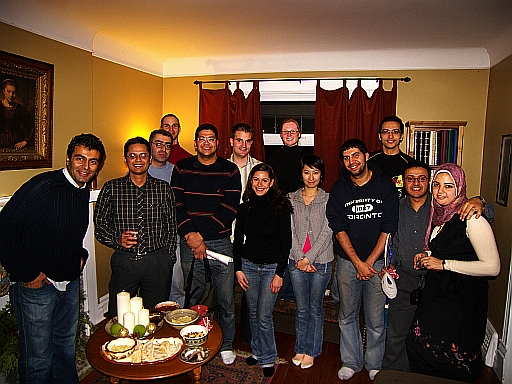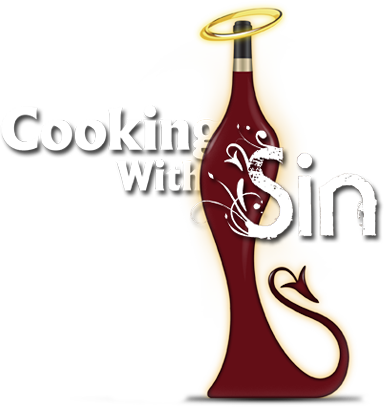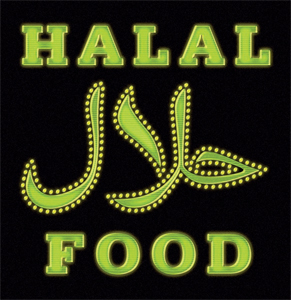by Dr. Matthew Roorda
 The University of Toronto is one of the most diverse institutions in the world. Engineering is even more so, in my research group only about one in four graduate students are Canadian-born. The majority are Muslim. So when I invited the graduate students last year to my house for dinner there had to be a Halal option. That was a challenge because I really didn’t have much experience with Halal. So I took my favourite recipe and went on the web to figure out what it would take to engineer a Halal option as best I could.
The University of Toronto is one of the most diverse institutions in the world. Engineering is even more so, in my research group only about one in four graduate students are Canadian-born. The majority are Muslim. So when I invited the graduate students last year to my house for dinner there had to be a Halal option. That was a challenge because I really didn’t have much experience with Halal. So I took my favourite recipe and went on the web to figure out what it would take to engineer a Halal option as best I could.
It is worthwhile to read up on and appreciate what Halal means, which takes some effort if you want to go directly to the Koran, but a web search on Halal works fine. Halal is actually more than just a way of preparing food, it means a way of living that is acceptable and permitted. It is not just what type of food, but how it has been raised slaughtered, prepared, etc. Cooking Halal is tricky for non-Muslims, because you are really supposed to use uncontaminated dishes, cooking surfaces, utensils and the like. To be careful, I suppose it is a good idea to check with your Muslim guests about this, but chances are if your guests accepted your invitation to dinner you will not be expected a meal cooked in a fully Halal kitchen.
Here is what can be changed with the recipe to make it “almost” Halal.
- Unfortunately all the wine has to be replaced. Some say that all the alcohol burns off when you cook, but this dish has a lot of wine, and would not fly as Halal unless you replace it. Water is too boring, white grape juice is too sweet. I just used extra broth.
- If you are using chicken broth cubes, best to replace them with vegetable broth, unless you find some Halal chicken broth, or make it yourself, which I never do.
- Buy Halal chicken. I had no trouble in Toronto, there was a Halal section in the grocery store, but it may be more enlightening to go to a Halal specialty food store if you have one around.
- To be strictly Halal you should be using counters, pans and dishes, stove that have not come into contact with Haram (forbidden) foods. The cutting surface is easy… just cut the Halal chicken in the Styrofoam. I compromised on the pan utensils and dishes and stove…I just cleaned them well (best to own up to this with your Muslim guests!).
- Since I was preparing both versions at the same time, I prepared the Halal version first, then the non-Halal version, and I used separate parts of the kitchen.
Needless to say, it was about twice the work to do all of this, but a fun experience. As it turned out, when I served this meal and dutifully disclosed that I had used “contaminated” dishes for the Halal version, I discovered that my students were not as observant as I thought (either that or they were being really very polite). They only really cared about the Halal meat and no alcohol. In fact, I ended up giving them the list of detailed rules that I had dug up on the web, which quite intrigued them. Anyway all of this was an interesting experience for me, my Muslim students were very grateful, and we had a fabulous evening.
But honestly, the forbidden dish is better!

“Forbidden” Chicken Breasts
Serves 4
Step 1: The sauce
2 tablespoon butter 1 tablespoon flour 3/4 cup dry white wine 1/2 cup of chicken broth 1/2 cup sour cream 1/2 cup Parmesan cheese 1/2 tablespoon prepared mustard 1/4 teaspoon pepperMelt margarine, add flour and cook 30 seconds, gradually add liquids, stir until thickened on low heat. Add remaining ingredients. Simmer 5 minutes more, while stirring. Remove from heat.
Step 2: The chicken breasts
2 tablespoon vegetable oil 1 tablespoon butter 1 medium onion, sliced 1 tsp dried tarragon 1/2 teaspoon thyme 4 chicken breasts, boned, halved, skinned 1/2 cup dry white wine 1 teaspoon salt 1/4 teaspoon pepper 1/4 cup parsley1. In large pan heat the oil and butter over medium-low heat. Add onion, tarragon and thyme. Cook until you have tender onions.
2. Add the chicken breasts, but try not to crowd them. Sauté 6-8 minutes, turning once.
3. Add wine, salt and pepper. Cover and simmer 5 more minutes. Take out the chicken and place it in a lightly greased baking dish, pour the sauce over the chicken and place under the broiler to heat and brown, about 5 minutes.
4. Sprinkle with parsley then serve with rice (pasta is okay too, but rice is better).
5. Serves four adults (or maybe three university students, depending on when they last ate). 

Tags: MeatHalal (Arabic:حلال, ḥalāl; means lawful or legal) is a term designating any object or an action which is permissible to use or engage in, according to Islamic law. It is the opposite of haraam. The term is used to designate food seen as permissible according to Islamic law (Sharia, الشريعة الإسلامية).
The terms halal and haram are both applied to many facets of life and one of the most useful uses of these terms is to refer to food items including meat products, food contact materials and pharmaceuticals. In Islam there are many things that are clearly halal or haram. There are also items which are not clear as if they are halal or haram and in order to categorize them as halal or haram further information is needed. Items that are not clear are called mashbooh which means questionable. In Islam the general idea of food is halal except the following:
Pork and all its products, animals improperly slaughtered, alcoholic drinks including all forms of intoxicants, carnivorous animals, birds of prey and any food contaminated with any of these products.











Interesting story! And educational! I had never heard of Halal before, thank you for sharing your knowledge. The forbidden chicken breasts recipe sounds great!
I am so happy to share this story. Matt is a really great guy and I have a lot of wonderful Muslim friends who would not normally get included in a project like this because alcohol is also sin in the Islam community.
As-Salam Alaykum!